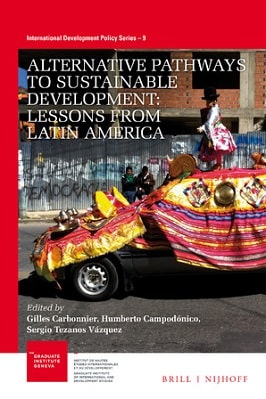
| Book Title | Alternative Pathways To Sustainable Development |
| Book Author | Sergio Tezanos Vázquez |
| Total Pages | 366 |
| Book Views | |
| Language | English |
| Book Download | PDF Direct Download Link |
| Get Hardcover | Click for Copy from Amazon |
Alternative Pathways to Sustainable Development: – Lessons from Latin America
Edited by Gilles Carbonnier – Humberto Campodónico – Sergio Tezanos Vázquez
ALTERNATIVE PATHWAYS TO SUSTAINABLE DEVELOPMENT
Alternative Development Narratives, Policies and Outcomes in the Andean Region
Since the early 2000s, many Latin American countries have achieved remarkable economic growth coupled with poverty and inequality reduction, largely due to the pursuit of a centuries-old pattern of commodity exports.
The end of the commodity price super-cycle in 2014 puts some of these development gains in jeopardy, raising anxiety among emerging middle classes wary of slipping back into poverty. Drawing on a rich intellectual heritage, Latin American leaders have designed novel approaches in the pursuit of sustainable development.
Alternative development narratives brought to the fore by left-wing governments have emphasised notions such as buen vivir,1 arguably the most influential and revolutionary proposition originated in the region since different variants of the dependency theory.
What is less clear is the extent to which competing ideologies and narratives have translated into diverging outcomes, be it with regard to (neo-) extractivism, ecological sustainability or the rights and cultural identity of indigenous peoples, or simply in terms of economic diversification.
This chapter introduces the thematic issue of International Development Policy, which deals with recent paradigmatic innovations and development experiences in Latin America, with a particular focus on the Andean region.
The outset of the 21st century brought something of a ‘boom time’ for many resource-rich countries. Driven to a large extent by robust growth in China and other emerging economies, commodity prices boomed from 2002 to 2014.
In many Latin American countries, the centuries-old pattern of producing large quantities of extractive resources and soft commodities for export intensified in the context of high prices for oil, gas, metals, minerals and agricultural products. This pattern has often been referred to as the ‘modelo primario exportador’
To read more about the Alternative Pathways To Sustainable Development book Click the download button below to get it for free
or
Report broken link
Support this Website
 Don't Miss out any Book Click Join OpenMaktaba Telegram group
Don't Miss out any Book Click Join OpenMaktaba Telegram group